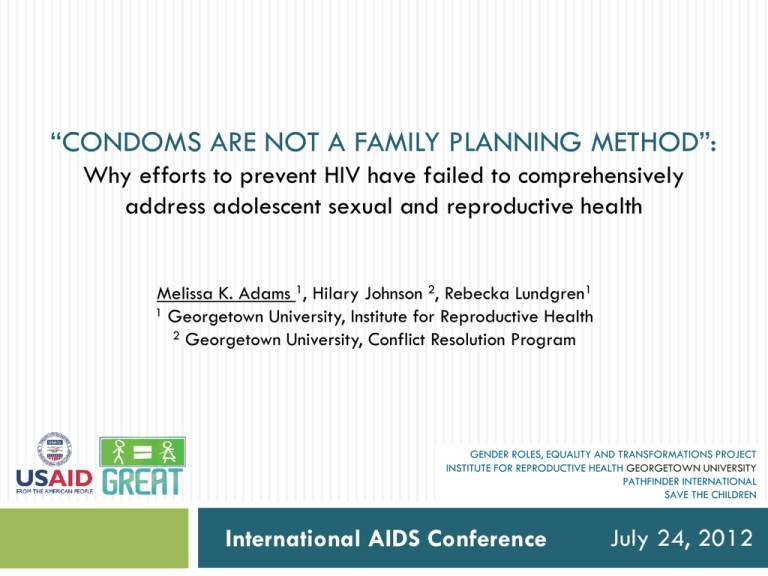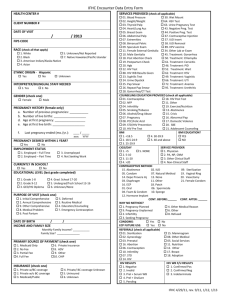
“CONDOMS ARE NOT A FAMILY PLANNING METHOD”:
Why efforts to prevent HIV have failed to comprehensively
address adolescent sexual and reproductive health
Melissa K. Adams 1, Hilary Johnson 2, Rebecka Lundgren1
1 Georgetown University, Institute for Reproductive Health
2 Georgetown University, Conflict Resolution Program
GENDER ROLES, EQUALITY AND TRANSFORMATIONS PROJECT
INSTITUTE FOR REPRODUCTIVE HEALTH GEORGETOWN UNIVERSITY
PATHFINDER INTERNATIONAL
SAVE THE CHILDREN
International AIDS Conference
July 24, 2012
The GREAT Project: Overview
Goal: Improve gender equity and
reproductive health outcomes in Northern
Uganda
5-year USAID funded project
Phase 1: 2010-2011
Phase 2: 2011-2015
Location: Northern Uganda
Prime: Georgetown University’s Institute for
Reproductive Health (IRH)
Partners:
Pathfinder International
Save the Children
Beneficiary Population: Adolescent boys and
girls, ages 10-19
Why Gender Norms?
STIs/HIV/AIDS
Use of family planning
RH decision-making
Parenting practices
Health seeking behaviors
Gender-based violence
Unintended/unplanned
pregnancy
Photo Credit: Save the Children/Chad Stevens
ASRH in Northern Uganda
Recovering from more than 20 years of
conflict
6.9% HIV prevalence (UAIS, 2011)
51.7% of women have experienced IPV
(Stark, 2010)
Low rates of adolescent condom and
contraceptive use
High rates of unintended pregnancy,
transactional sex, GBV, and induced
abortion among adolescent girls
Photo Credit: Pathfinder
Ethnographic Research Objectives
Understand how gender norms are learned, internalized and
passed on;
why individuals would be motivated to change these norms;
and how these norms shape GBV, SRH, and FP behaviors in
post-conflict Northern Uganda.
Research Design and Methodology
Ethnographic, participatory, life course-tailored and activity-based
Data collection designed with youth in mind and took place from March 2011October 2011
40 Life Histories collected from adolescents & 40 in-depth interviews with
influencing adults
All interviews were translated, transcribed, coded and analyzed using AtlasTi
Life histories with 40 adolescents at different stages in the life course
Life
Course
Stages
Very Young
Adolescents
Older Adolescents
Newly Married
Pregnant with 1st child/
Parenting 1 child
40 in-depth interviews with adults selected by life history participants and directly recruited:
Parents/Guardians
Teachers
Peers
Siblings
Religious/Community Leaders
Extended Family
Outline of Key Findings
Norms
Barriers
• Fertility viewed as essential component of masculinity and femininity
• Men are decision-makers and women are obedient
• Lack of support for youth access to FP services
• Limited power and decision-making abilities for young women
•
•
•
Outcomes •
Limited access to FP services for young women
Covert use of contraceptives
Unplanned pregnancy
Unsafe abortions
Key Findings: Gender norms and
Fertility
Traditional attitudes toward gender roles held
across the life course
Fertility linked to ideal masculinity and femininity
Strong norms for when and how pregnancy occur
Prevailing gender norms significantly shape fertility
desires and intentions among young people
Hopes and Dreams
I: Among all your hopes, which one is the
greatest? You talked of education having a
job, and your ability to give birth.
P: Giving birth is the most important. In this
world if you don’t have a child then your
life is worthless and people will insult you.
Female, 16, older adolescent
Key Findings: Attitudes toward HIV Services
and Youth
HIV prevention services appear widely available
Strong community support for youth access to HIV
services
Puberty brings fear of HIV and “falling in love”
HIV testing has become a courting ritual and rite of
passage into sexual relationships
Entering relationships
“The girl should know the boy’s results and the same for the
boy; he should know the girl’s results and the test should be
done three times. Then they are free to have a relationship.
Female, 55, Community Member
Key Findings: Attitudes toward adolescent
contraceptive use
Limited integration of pregnancy prevention into ASRH
services
Condoms not associated with FP
Limited community support for youth access to FP services
Gendered barriers to adolescent use of FP include:
Lack of support from male partners
Fear of marital discord
Concern over side effects
Stigma
Fear of sterility
Not Family Planning
P: Condom is good. It is because a condom will help your life.
Because, if you have sex with a boy with a condom it will
prevent the transmission of diseases. Family planning is the
one that is bad.
I: Condom is also among family planning.
P: No. That is not true.
Female, 19, Peer
Conclusion
Severe social, economic, and health
consequences related to early pregnancy
Failure to comprehensively address ASRH further
undermines HIV prevention efforts
Results from study used to design, implement, and
test life-course specific interventions that promote
dialogue and reflection to challenge inequitable
gender norms and improve ASRH
The GREAT Intervention Model




